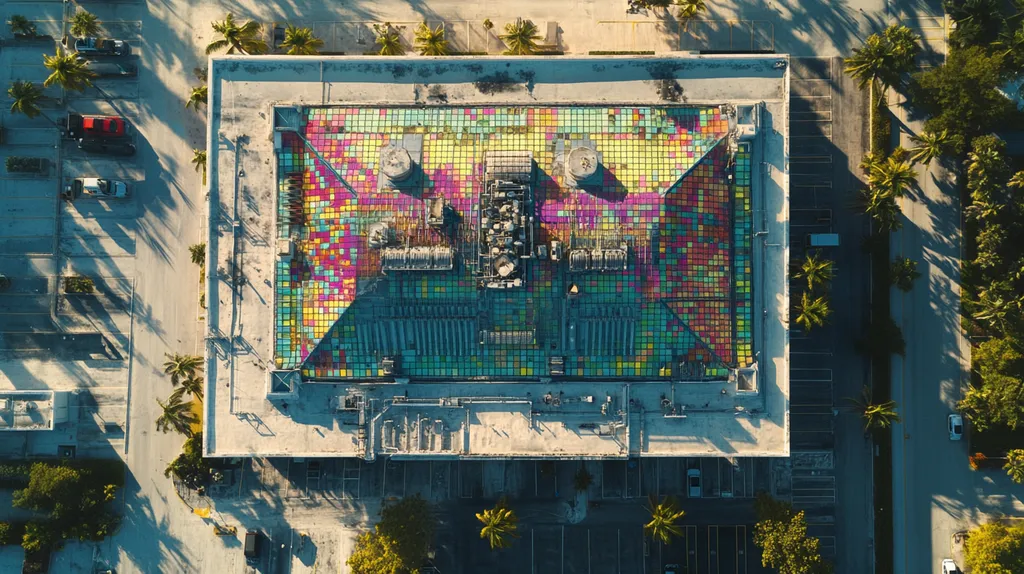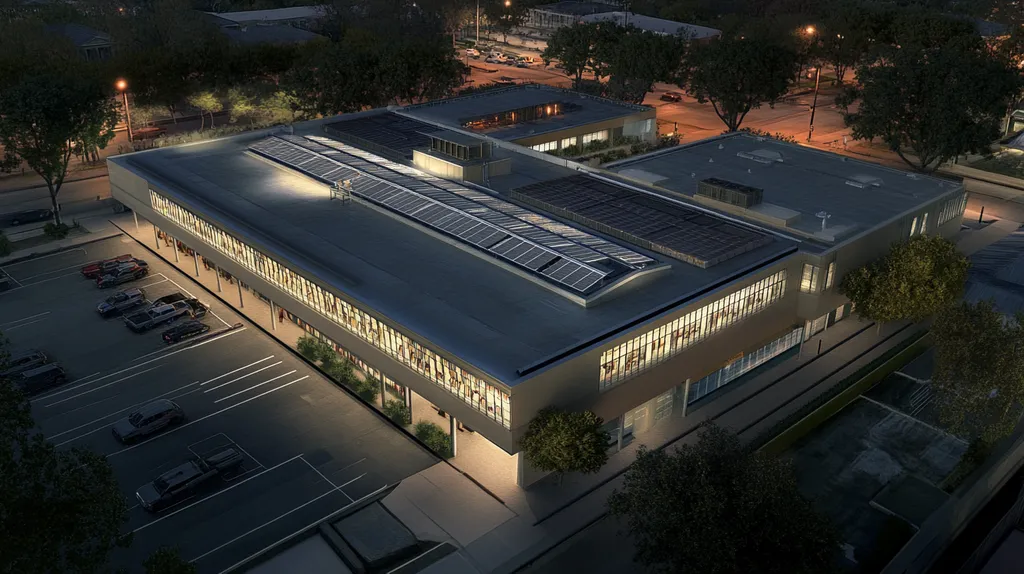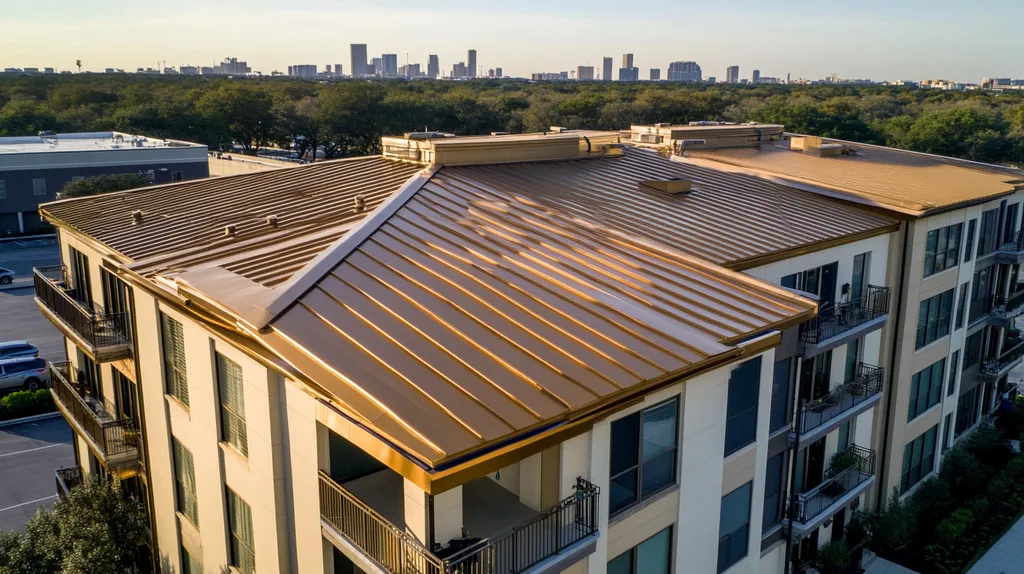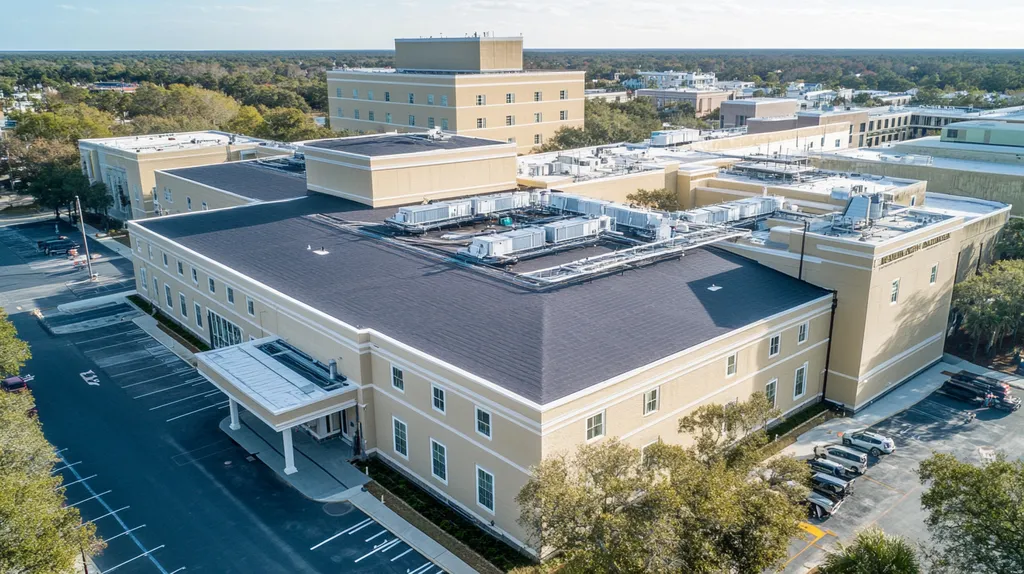In an era where commercial roofing failures cost businesses over $3.5 billion annually, traditional maintenance training methods are proving dangerously inadequate. Industry data reveals that 70% of roof-related accidents stem from improper maintenance practices, pointing to critical flaws in how we prepare our workforce.
From outdated curricula to insufficient hands-on experience, the current approach to roof maintenance training leaves dangerous gaps in knowledge and execution.
This analysis exposes six fundamental problems plaguing commercial roof maintenance education and presents data-driven solutions for property owners and facility managers seeking to protect their investments.
SECTION 1: CURRENT PRACTICES
When it comes to commercial roof maintenance, many training methods seem stuck in a time capsule, failing to keep pace with modern demands. Alarmingly, over 30% of facility managers report that inadequate roof care has led to equipment damage. This statistic underscores the immediate need for revamped training practices that mitigate risks and prolong roof longevity. Three critical issues require attention: a reliance on outdated training formats, limited hands-on experience, and noticeable gaps in industry certifications. Addressing these challenges is vital for effective maintenance strategies.
Standard Training Formats
Many commercial roofing training programs are akin to lecture marathons that leave participants yearning for a hands-on finish. While these traditional classroom formats impart essential theoretical knowledge, they often neglect practical applications. Facility managers should recognize that acquiring skills through endless presentations doesn’t adequately prepare teams for the unpredictable challenges they will face on the job.
Additionally, these cookie-cutter training approaches skim over a vast range of topics without diving deep into any specific area. This lack of focused training often leaves maintenance personnel feeling stranded when confronted with specific issues. The superficiality of training can lead to misunderstandings, ultimately compromising roof integrity.
As the industry continues to evolve, so too should training practices. A shift towards blended learning—incorporating online modules along with in-person workshops—could bridge existing gaps. This approach, featuring engaging content and instant feedback, can significantly enhance skill retention and application.
Taking the time to upgrade training formats is crucial. Learning environments should empower teams with immediately applicable knowledge, dramatically improving maintenance results.
Limited Hands-On Experience
The importance of hands-on experience in roofing maintenance cannot be overstated. Yet, many training programs fall short in providing this vital element. Facility managers frequently find that trainees emerge with little practical skill, which can lead to errors during maintenance tasks—potentially resulting in structural issues or safety hazards.
With insufficient opportunities for real-world practice, personnel often lack the readiness to tackle unexpected challenges. For example, a sudden leak or storm damage requires quick, confident responses that book smarts can’t provide. Without the benefit of hands-on experience, the risk of mismanagement escalates significantly.
Enhancing training methods to include more practical experience is essential. Simulation-based training could immerse employees in scenarios they are likely to encounter, allowing them to practice responses in a controlled environment. This not only builds confidence but also sharpens problem-solving skills.
Focusing on practical experience in training will set personnel up for success. Facility managers should champion programs offering rich, hands-on exposure to ensure teams are fully equipped for any situation they might face.
Industry Certification Gaps
Certification is often viewed as an emblem of expertise in the roofing industry, yet many existing credentials do not align with contemporary best practices. Consequently, numerous workers hold outdated certifications that fail to adequately reflect their skills, leading to poor maintenance outcomes and safety compliance challenges.
Moreover, many certifications do not require ongoing education, leaving technicians unaware of new advancements in roofing materials and techniques. A roof system developed a decade ago may be incompatible with today’s innovations, raising concerns about maintenance effectiveness.
The industry urgently needs updated certification programs that mirror current practices. Implementing regular recertification can help ensure all personnel remain informed about the latest developments and protocols, thereby enhancing overall roof maintenance practices.
Bridging certification gaps is essential for elevating the industry’s competency. Stronger certifications that mandate continuous education will cultivate a more skilled workforce, bringing benefits not only to property owners but also to the roofing industry as a whole.
SECTION 2: SYSTEMIC ISSUES
The state of commercial roofing maintenance is akin to a leaky faucet—persistent and costly if left unattended. Alarmingly, a recent study found that 60% of roofing failures stem from inadequate maintenance protocols. This stark reality signals a need for urgent reform in training practices. Critical areas of focus must include safety protocols, regulatory compliance, and ongoing education for maintenance workers, as each plays a pivotal role in ensuring reliable roofing operations.
Inadequate Safety Protocols
Safety is not just a checkbox on a to-do list; it should be the bedrock of any roofing maintenance program. Yet, far too many training regimens neglect essential safety protocols, leaving workers at risk. For instance, without proper fall protection training, employees working on steep roofs are vulnerable to serious injuries, turning what should be a routine task into a potential disaster.
Statistics reveal that falls remain the leading cause of fatalities in construction. This sobering fact amplifies the necessity for structured safety training that not only informs but empowers workers. By fostering awareness around safety risks, organizations can significantly diminish the accident rate on commercial rooftops.
Moreover, inadequate safety training doesn’t just put lives at risk; it can lead to skyrocketing insurance premiums for companies. However, this financial burden can be avoided by adopting effective training programs that make safety a priority from day one. A commitment to thorough safety training ultimately contributes to a safer work environment, protecting both employees and the bottom line.
Code Compliance Oversights
In the world of roofing maintenance, following local building codes isn’t optional; it’s crucial. However, many maintenance teams work without a full grasp of these regulations, leading to costly penalties and potential legal troubles. For example, failing to comply with proper drainage regulations can result in water damage and mold growth, undermining a building’s long-term value.
The gap in training regarding local codes poses significant risks for property owners. It’s essential to ensure that every team member understands and applies the pertinent regulations. A proactive approach to compliance can prevent incidents that threaten both buildings and reputations.
Additionally, many traditional training methods lag behind recent changes in building codes. This lack of adaptability can perpetuate compliance issues and hinder operational efficiency. Regularly updating training materials is necessary to keep pace with evolving legal standards, safeguarding investments.
Lack of Continuous Education
The roofing industry is in a constant state of flux, with new materials and technologies hitting the market at a rapid pace. Despite this dynamic landscape, many existing training programs fail to provide pathways for continuous education, leaving maintenance teams ill-equipped to utilize industry advancements.
Regular training updates are vital for keeping crews informed about the latest products and installation techniques. Without continuous education, teams risk applying outdated methods, leading to inefficient maintenance and costly repairs.
Moreover, a workforce deprived of ongoing training opportunities may find themselves disengaged and demotivated. This lack of motivation can translate into diminished performance and elevated turnover rates. It falls on organizations to create an atmosphere that values learning and development for their roofing teams.
By prioritizing continuous education, companies can maintain a competitive edge while ensuring their teams are highly skilled. This investment not only elevates maintenance quality but also raises the overall standard of service, benefiting property owners in the long run.
SECTION 3: MISSED OPPORTUNITIES
In the ever-evolving world of commercial roofing, opportunities for improvement are often left unaddressed. Property owners and facility managers commonly overlook innovative advancements that would significantly enhance the efficiency and longevity of roof maintenance. A telling statistic from the Roofing Industry’s 2021 report highlights that companies resistant to modern roofing materials face repair costs soaring up to 30% higher than their forward-thinking counterparts. This section underscores three key areas where inadequate training stifles effective roof management: advanced materials, marketing strategies, and networking possibilities.
Neglect of Advanced Materials
Many property managers cling to outdated roofing methods, unaware of the treasure trove of benefits that advanced materials offer. Modern options, like thermoplastic polyolefin (TPO) and ethylene propylene diene monomer (EPDM), boast enhanced energy efficiency and remarkable durability. Alarmingly, only 25% of property managers surveyed by the National Roofing Contractors Association actively explore these materials during maintenance training.
This blind spot opens the door to vulnerabilities. Continuing to rely on traditional materials can lead to increased energy consumption and faster deterioration. As older roofs deteriorate, property owners are left grappling with skyrocketing repair bills and displeased tenants.
Investing in training that emphasizes these advanced materials can unlock significant long-term savings. For example, roofs treated with reflective coatings can reduce cooling costs by up to 20%. By embracing innovation, property management can bolster their financial bottom line and significantly extend the life of their assets.
Yet, without proper training on these advancements, valuable insights remain elusive, leaving managers to struggle with outdated notions and strategies.
Insufficient Marketing Training
Marketing plays a pivotal role in roof maintenance, yet it often takes a back seat in planning processes. Property owners frequently miss the chance to highlight their commitment to quality by effectively promoting their adoption of new roofing technologies. An analysis shows that organizations with dedicated marketing training experience a remarkable 40% uptick in tenant engagement and satisfaction.
Typically, property managers focus on immediate maintenance concerns, neglecting to communicate the long-term benefits of their investments. Training programs that overlook marketing essentially create widening gaps in communication, resulting in missed opportunities.
Moreover, effective marketing strategies can invigorate relationships with roofing contractors and suppliers, leading to collaboration and innovation. A well-crafted marketing approach can spotlight a facility’s unique roofing solutions, thereby attracting new business and forging valuable partnerships.
In essence, a lack of marketing training can stifle growth and impede the effectiveness of maintenance programs. Engaging all stakeholders can transform roof maintenance from a dreaded cost center to a compelling selling point.
Underutilized Networking Opportunities
Networking serves as a critical avenue for growth that many property owners fail to explore. Engaging in industry events and forums can unlock doors to enriching ideas and valuable partnerships. Yet, the absence of networking training leaves many facility managers isolated from essential resources.
For instance, participating in trade shows or becoming active members of professional associations enables managers to exchange best practices and glean insights from industry leaders. Networking opens the floodgates to emerging technologies and refined maintenance processes flourishing in other markets.
By ignoring these avenues, organizations limit their access to collaboration and knowledge-sharing opportunities. Engaged professionals can gain insights into advancements that may not yet be prevalent in their regions, ensuring they stay competitive.
Without integrating networking into training programs, many facility managers risk operating in a vacuum, making them susceptible to the pitfalls of outdated practices and stale ideas. Acknowledging the power of networking is crucial for keeping pace in the dynamic roofing landscape.
SECTION 4: ROOT CAUSES
The world of commercial and industrial roofing is fraught with challenges, often stemming from inadequate maintenance training. Alarming statistics reveal that a staggering 70% of roof failures can be traced back to insufficient maintenance practices. This section will explore the root causes of ineffective training programs and their far-reaching consequences. Understanding these fundamentals is crucial for property owners and facility managers aiming to protect their investments.
Outdated Curriculum Design
The educational backbone of commercial roof maintenance often clings to outdated teachings that serve little purpose in today’s rapidly changing environment. Many programs still favor antiquated techniques, ignoring modern challenges such as climate change and innovative roofing materials. This reliance on yesterday’s knowledge can leave maintenance teams fumbling when faced with current inspection demands.
Furthermore, typical curricula often lack practical, hands-on learning experiences, hindering trainees from fully grasping essential skills. Imagine the thousands of roof leaks that could have been avoided if maintenance personnel were trained in today’s advanced leak detection technologies. This disconnect with current roofing demands ultimately jeopardizes a building’s integrity.
Additionally, outdated training programs may overlook essential tools, such as advanced roof monitoring software. Without familiarity with such innovations, property managers risk incurring hefty repair bills and potential safety issues due to undetected roofing troubles. The industry suffers increased risks and elevated costs as a result.
To foster competent maintenance teams, an updated curriculum that incorporates contemporary techniques is crucial. By integrating real-world tools and evolving best practices, training can be made more relevant and effective, setting the stage for success.
Inexperienced Instructors
In the intricate dance of roofing maintenance training, the quality of instructors plays a pivotal role. Regrettably, many sessions are conducted by individuals without extensive field experience or technical expertise. This deficiency translates into a lackluster learning experience that constrains the proper implementation of vital maintenance protocols.
Instructors who are primarily grounded in theory may struggle to relate their teachings to the practical challenges maintenance teams encounter regularly. For example, without hands-on experience addressing real-world emergencies, instructors may miss conveying practical solutions. Such disconnection risks normalizing detrimental practices within organizations.
Furthermore, inexperienced instructors limit opportunities for vital questions and interactive feedback. The benefit of engaging with seasoned professionals is immeasurable, as their substantial experience can provide trainees with relevant, situational insights essential for effective problem-solving. Practical demonstrations led by experts can considerably enhance understanding and confidence in roofing tasks.
Correcting the issue of unqualified instructors is vital for building a skilled workforce. Incorporating experienced professionals into training programs can bridge knowledge gaps, fostering a deeper understanding of the complexities involved in commercial roofing.
Limited Feedback Mechanisms
Feedback is the heartbeat of effective training, yet many maintenance programs tend to overlook this critical component. Without mechanisms to assess participant understanding and program efficacy, training can drift away from the realities of daily operational needs. This disconnect creates an environment where unresolved questions linger, leading to confusion among trainees.
Moreover, participants often miss the chance to express challenges or suggest improvements. This lack of dialogue squanders precious time and resources, resulting in training that fails to evolve with the demands of commercial roofing. As a consequence, maintenance staff may find themselves entrapped in outdated practices, feeling ill-prepared for diverse roofing scenarios.
In addition, feedback is essential for evaluating the grasp of key concepts and techniques imparted during training. Implementing regular assessments cultivates a culture of accountability and encourages continuous growth. Programs that invite participant input showcase a commitment to delivering valuable training aligned with current industry requirements.
Strengthening feedback mechanisms within training initiatives can dramatically elevate their quality and relevance. When property managers and facility staff play an active role in shaping curricula, they ensure they receive the knowledge and tools necessary to maintain their roofs effectively.
DATA DRIVEN EVIDENCE
The stakes in commercial roofing maintenance have never been higher. Each year, businesses experience significant financial losses due to roof failures, resulting in expensive repairs and unsafe working environments. Alarmingly, statistics indicate that over 25% of commercial roofs develop leaks within just the first year if proper maintenance is neglected. This section dives into the critical issues surrounding safety risks, economic inefficiencies, and customer satisfaction metrics linked to traditional roofing methods.
Statistical Safety Risks
Failing to provide adequate training in commercial roof maintenance can escalate safety risks dramatically. Data demonstrates that accidents stemming from poorly maintained roofs result in thousands of injuries annually. Inadequate inspections often miss crucial issues like hidden leaks or structural weaknesses.
Moreover, untrained personnel may overlook hazards, such as slippery surfaces or exposed materials, inviting serious accidents that jeopardize both workers and business operations.
Organizations must make ongoing training a priority to ensure safe roof maintenance practices. Implementing a structured training program can drastically reduce workplace injuries linked to negligence.
Ultimately, the human cost of inadequate training is intolerable. Businesses owe it to their workers to invest in comprehensive roof maintenance education.
Economic Impact of Inefficiencies
The financial implications of inefficient roofing practices are staggering. A recent analysis revealed that poorly maintained roofs lead to an average 15% increase in operational costs. This inefficiency results from frequent repairs and energy loss due to inadequate insulation.
Additionally, traditional maintenance approaches often mean unnecessary service calls and prolonged downtime. Each incident not only incurs repair costs but also hampers productivity and revenue.
Property owners need to recognize that proactive maintenance training can alleviate these financial burdens. By equipping teams with the right knowledge and skills, they can avoid costly emergencies and extend their roofs’ lifespan.
Investing in data-driven maintenance strategies enhances resource allocation and significantly improves overall financial performance.
Customer Satisfaction Metrics
Customer satisfaction is increasingly tied to the quality of a property’s infrastructure, such as its roofing. Surveys reveal that over 70% of tenants express dissatisfaction when roofing issues arise, which can lead to lease terminations and lower retention rates.
A well-maintained roof is also a strong signal of overall property care. Buildings that show a commitment to maintenance often see increases in occupancy rates and tenant trust. Clearly, the connection between roof quality and customer satisfaction is critical and should not be ignored.
Investing in employee training for roof maintenance directly influences how clients perceive value. Firms that prioritize continuous education are likely to enjoy higher satisfaction levels among tenants.
In a competitive marketplace, addressing customer concerns through effective maintenance practices is vital for long-term success.
SECTION 6: ALTERNATIVE SOLUTIONS
In a field where roof maintenance is not just a task but a lifeline for properties, traditional training methods often miss the mark. With a staggering 40% of commercial roofs suffering early failures due to poor upkeep, there’s an urgent call for effective training solutions. Alternative training methods can transform how teams manage and maintain roof systems, geared toward practical know-how and longevity.
Integrated Hands-On Training
Integrated hands-on training revolutionizes the way practical skills are taught in roof maintenance. This approach blends theoretical knowledge with real-world applications, allowing trainees to engage in on-site learning experiences where they can apply techniques immediately.
For facility managers and property owners, witnessing the tangible impact of this training format is invaluable. Workshops that incorporate physical roof inspections not only reinforce theoretical lessons but also directly result in fewer maintenance errors. This means a longer lifespan for roofs and, subsequently, a more robust financial outlook.
Furthermore, hands-on training fosters teamwork among staff. Collaborating on maintenance tasks builds camaraderie, ensuring every team member understands their role in caring for the roof. This culture of cooperation nurtures consistent and effective maintenance practices over time.
As roofing technologies continue to evolve, integrated training keeps employees up-to-date on the latest tools and methods. Being prepared to tackle emerging challenges is crucial, and hands-on training lays the foundation for future success.
Customizable Certification Programs
Customizable certification programs present a personalized approach to training that aligns with the specific needs of individual facilities. Unlike generic courses, these programs focus on the unique environmental factors and roofing types pertinent to each property.
By tailoring content to actual situations, property owners can maximize their training budgets. This means avoiding unnecessary expenses on irrelevant material and investing in training that tangibly benefits their roofs. For instance, a course addressing maintenance for a TPO roof is undoubtedly more relevant than a broad, catch-all training program.
Moreover, these certification programs can be continuously updated to reflect the latest industry trends. This adaptability keeps facility managers and their teams competitive and knowledgeable, offering them pathways to remain well-informed about cutting-edge practices and materials.
Most critically, certified employees help cultivate a culture of safety and adherence to best practices. Well-trained staff are more likely to implement compliance measures effectively, significantly reducing potential hazards and liabilities associated with roof work.
Ongoing Support and Resources
Even after certification, ongoing support and resources are vital for sustaining training effectiveness. A strong support system may include accessible online resources, refresher courses, and direct channels to roofing experts, ensuring employees feel supported beyond their initial training.
Regular webinars and Q&A sessions offer new perspectives on best practices, keeping maintenance teams well-informed and agile. This continued learning empowers staff to adapt swiftly to changes in technology and materials, equipping them to tackle unique roofing challenges.
Establishing a mentorship program can add immense value. Pairing experienced team members with newcomers fosters on-the-job training so fresh talent can effectively apply their knowledge. This nurtures trust and a shared commitment to roof care within the team.
Finally, ongoing support cultivates accountability in roof maintenance. Teams that feel empowered with knowledge are more likely to take ownership of their responsibilities, leading to proactive maintenance strategies that prevent rather than react to issues.
Moving Forward
With over $3.5 billion lost annually to roofing failures and 70% of accidents traced to inadequate maintenance training, the industry stands at a critical crossroads.
Traditional training methods have proven dangerously insufficient in preparing workers for modern roofing challenges.
The evidence demands a dramatic shift toward integrated hands-on training, customizable certification programs, and robust ongoing support systems.
Without immediate action to reform commercial roof maintenance training, property owners face escalating risks of catastrophic failures, preventable accidents, and mounting repair costs.
The path forward requires abandoning outdated practices in favor of data-driven, practical education that emphasizes safety, efficiency, and long-term roof performance.
FREQUENTLY ASKED QUESTIONS
Q. What are the current practices for commercial roof maintenance training?
A. Current practices often lean on outdated training formats, which lack practical application. Many facility managers report insufficient hands-on experience and training gaps, resulting in ineffective roof maintenance. Strategies should pivot toward blended learning that includes both theoretical and practical elements for improved skill retention.
Q. How do systemic issues affect commercial roof maintenance?
A. Systemic issues in maintenance training often result from neglected safety protocols and code compliance. Many workers lack the comprehensive knowledge required to handle unforeseen maintenance challenges. Without proper training, organizations face heightened risks and costly mistakes, jeopardizing both safety and building integrity.
Q. What are some missed opportunities in commercial roof maintenance training?
A. Missed opportunities often involve neglecting advanced materials and innovative marketing strategies. Many property managers overlook the benefits of modern materials, leading to higher long-term costs. Additionally, failing to communicate investments in new technologies can result in diminished tenant satisfaction and lost business potential.
Q. What root causes lead to ineffective commercial roof maintenance training?
A. Ineffective training often arises from outdated curriculum designs and inexperienced instructors. Many programs fail to adapt to modern challenges or provide real-world applications. As a result, trainees do not develop the necessary skills to address current roofing issues effectively.
Q. How does data drive evidence related to commercial roof maintenance?
A. Data-driven evidence highlights the significant risks and costs associated with neglecting proper maintenance. Statistics reveal that over 25% of roofs experience leaks within a year of inadequate maintenance. Acknowledging these data points can prompt property owners to prioritize training for improved safety and financial performance.
Q. What are alternative solutions for commercial roof maintenance training?
A. Alternative solutions emphasize integrated hands-on training, customizable certification programs, and ongoing support. These approaches foster practical application, ensuring trainees can effectively manage real-world scenarios. By personalizing training content, organizations can cater to specific roofing challenges, enhancing overall maintenance efficacy.
Q. Why is ongoing training important for commercial and industrial roof maintenance?
A. Ongoing training is crucial for keeping teams updated on new materials and techniques. The rapid evolution of the roofing industry means continuous education helps maintain high standards of safety and efficiency. As technologies evolve, workers need to adapt to avoid costly errors and ensure roofs are well-managed.











